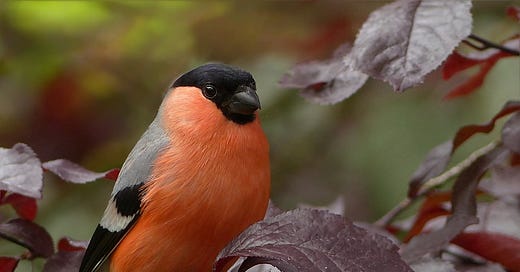The quiet whistle of the bullfinch is a subtle sound, but distinctive once it’s lodged in your ear. Bullfinches use this plaintive call to keep in touch with one another in the woodland, dense hedgerows and tangled corners they call home.
This is one of easiest bird calls to mimic, as it’s so like a human whistle. Imagine you’ve just experienced a minor disappointment, and then whistle ‘oh’.
Once you’ve heard one, the trick is to see it.
Bullfinches don’t sit out in the open as much as other finches tend to, preferring to be among the leaves. Even the males, with their stronger pink-red chests and bellies, are easy to miss.
The clinching feature is often the broad white rump, visible when they fly. If you are tracking bullfinches along a line of trees, with luck one or more them will fly in front of the greenery or across your path, low enough for that flash of white to show.
The song of the bullfinch is as unobtrusive as the rest of the bird’s behaviour.
It’s a series of off-key fluty notes mixed in with those whistles (as in the recording above). The whole thing is easily lost among a chorus of more extroverted species.
And yet, this modest offering belies their abilities, because bullfinches are adept mimics, and can be taught to whistle a human tune like a parrot.
Some can master up to three tunes. This made them sought-after in the 19th century, when they would be kept and trained.
Have a listen to this jaunty number, as featured on Autumnwatch. As the human listeners note with feeling: it’s hard to believe it’s made by a bird.
About a third of our bullfinches have disappeared since the 1960s, apparently declining along with the availability of thick cover and large orchards. But they are still widespread across Britain, away from the uplands and bare coastal areas.
Listen for that disappointed sound whenever you’re in a tall tangle.
You never know what’s next
What does the above bird look like to you? A warbler? Maybe a Common Chiffchaff?
If I’d seen it sitting quietly in the trees that’s the assumption I would have made. I suspect I would have moved quickly on.
Lucky for us this bird was singing when a friend and I walked past it in local woodland yesterday. It turned out to be a new species for both of us, and the rarest bird I’ve found in nearly 40 years of birding. 🤓
I haven’t found a neat way to describe the song of Iberian Chiffchaff, which turns up as an occasional vagrant to Britain from Spain and Portugal. It’s simple and rather sweet, and loud, and persistent, having something of both Common Chiffchaff and Chaffinch to it.
I certainly wouldn’t have been confident to put a name to the sound without help (thank you Collins Bird Guide, WhatsApp, and local birding buddies). But the fact that it sounded different was enough reason for us to track the bird down, and eventually it led us toward the right conclusion.
A good reminder of what, for many of us, makes watching and listening to birds such an enduring fascination: you just never know what’s next.
If you would like to join a live early bird-listen with me via Zoom, our next free Up With The Birds session is Saturday 20 May at 6am BST. Sign up here.
For those of you in East Sussex or near enough, I’m leading an evening birdsong walkshop at Herstmonceux Castle on Friday 19 May. Tickets here.
For course announcements and future events, sign up to the Birdsong Academy newsletter.
Wherever you are, enjoy the birds.
~ Charlie
Media credits:
Thanks to Soundcloud user julianclem for the recording of Bullfinch, and to oldiefan on Pixabay for the main image of Bullfinch.
Thanks to Chris Ball for the image of the Iberian Chiffchaff






Wonderful. Thank you.
Lovely. Every morning I listen to the birds as I’m walking home from dropping my son off at school. I’d love to be able to identify more of them. The wrens are so loud though I struggle to filter out what else I can hear 😂 I love the wrens song though, I think it has to be my favourite